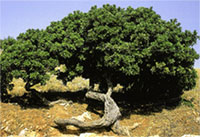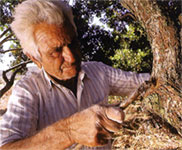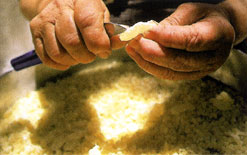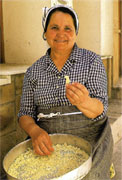|
|
|
Mastic
 Below
the low, sclerophyllous evergreen growth of the
maquis tree, the form of vegetation that is so
characteristic of the Mediterranean area, there is a
shrub which only occurs on the south of the island
of Chios. This is the subspecies Pistacia lentiscus
var. chic, the mastic bush. When its bark is
damaged, it exudes a sweet smelling, white,
transparent resin, already much prized in ancient
times. It was particularly valued for its
stickiness, which is preserved, indeed only really
develops, when a lump of resin is chewed. So it was
used very early on, mainly for oral hygiene.
Dioskourides refers to it in his pharmacology as a
cosmetic substance. Because of its scent it was used
in perfumes and as incense for improving the air.
The oil obtained from the resin was used to ward off
colds, coughs, and sneezes. Below
the low, sclerophyllous evergreen growth of the
maquis tree, the form of vegetation that is so
characteristic of the Mediterranean area, there is a
shrub which only occurs on the south of the island
of Chios. This is the subspecies Pistacia lentiscus
var. chic, the mastic bush. When its bark is
damaged, it exudes a sweet smelling, white,
transparent resin, already much prized in ancient
times. It was particularly valued for its
stickiness, which is preserved, indeed only really
develops, when a lump of resin is chewed. So it was
used very early on, mainly for oral hygiene.
Dioskourides refers to it in his pharmacology as a
cosmetic substance. Because of its scent it was used
in perfumes and as incense for improving the air.
The oil obtained from the resin was used to ward off
colds, coughs, and sneezes.
In the Middle Ages, it was the Genoese in particular
who carried on the trade in mastic throughout the
Mediterranean area and helped the island to achieve
relative prosperity. During the time of Ottoman rule
on Chios, the Sultan permitted the inhabitants to
continue the mastic trade virtually unhindered.
However, instead of taxes he demanded an annual
tribute of half the production of this valuable raw
material, a large part of which ended up in the
seraglio in Istanbul, the sultan's harem, where it
was used as chewing gum. In addition, mastic soon
found a use as a food additive. Though the mastic
farmers of Chios were highly regarded throughout the
Middle Ages in Greece, the few farmers left today
must fight for survival. Even if growing conditions
on Chios are good for the shrub, and the resin is
still used, it is under increasing pressure from
synthetic resins, except for flavoring the ouzo
produced on the island. The resin, which is traded
in the form of a firm, granular material, is used
among other things as an element in the formulation
of adhesives, special cements and varnishes, and as
an aromatic additive to incense, toothpaste, and
chewing gum (Greek: mastikha). Mastic has an
unusually intense taste and a fragrant, flowery
aroma and is therefore used in various Greek and
oriental sweets or confections such as khalvas and
loukotimia. |
 |
 |

|
The much
praised resin
flows from the cuts |
The surface of
the mastic crystal is
cleaned with a pointed knife |
The pieces of
collected resin come in different shapes and
sizes |
|
|
Mastic collecting begins in the middle of August,
when up to eight cross-shaped cuts are made in the
bark, so the resin can flow out and set. It takes
about 15 days to dry before it can be collected. The
grains of mastic are sifted to remove pollutants
such as sand, then it is washed with cold water and
soap, and laid out to dry. At the same time, the
last particles of dirt are scratched off with a
knife. Finally, it is sifted again, during which the
individual lumps or "tears" of resin are sorted
according to quality and size. |
excerpts from:
"Culinaria Greece"
|
Copyright ©2001 - 2008
GreekCuisine.com. All rights reserved.
GreekCuisine.com is part of the
GoGreece.com network
2665 30th Street Suite 214, Santa Monica, CA 90405 USA
|